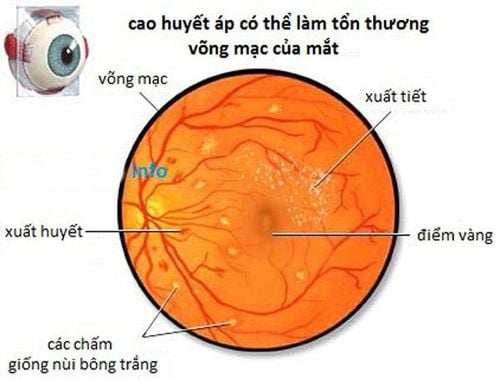This is an automatically translated article.
The article was professionally consulted by an eye doctor - Department of Examination & Internal Medicine - Vinmec Hai Phong International General HospitalCross-eyed (strabismus) is a common disease in children, the disease can also occur in adults and can be inherited in families. Eyestrain affects the patient's eyesight, psychology and quality of life quite a lot.
1. What is strabismus (strabismus)?

Lé mắt (lác mắt) là bệnh lý hay gặp ở trẻ em
In the eyes of normal people, the two eyes will look at the same point. (suitable) At this point, the eyeball will synthesize the image. Image obtained in 2 eyes into a single image, which is a 3-D image, for delicate vision.
Meanwhile, strabismus (strabismus) is a condition in which the two eyes are not balanced, vision in different directions. In people with strabismus, one or both eyes look in an inward or outward direction. This is a disease that usually occurs in young children, in some cases it is seen in newborn babies. In addition, the disease can also occur in adults.
When 1 eye is misaligned, 2 different images received by 2 eyes will be transferred to the brain. In young children, the brain selectively discards the image of the misaligned eye, taking only the image of the better looking eye. Later, children will lose their fine eyesight. In adults, the brain captures both images, unable to remove the image from the misaligned eye, causing double vision.
There are 2 types of strabismus:
Functional strabismus (companion strabismus): Common in children, characterized by the condition that the crossed eye always moves in the same direction as the healthy eye; Strabismus (companion strabismus): Common in adults, characterized by paralysis of the ophthalmic muscles that limit movement of the eyeball. Depending on the nature, strabismus manifests in different forms, such as A, V, strabismus, diagonal strabismus, etc. Lazy eyes can appear in 1 or both eyes. Over time, the strabismus often weakens and gradually loses vision because the brain only uses signals sent from the stronger eye.
2. Causes of strabismus
Paralysis occurs when the 6 muscles around the eye do not work in harmony with each other. This is caused by:Family history; Congenital or acquired oculomotor paralysis; Brain problems: Cerebral palsy, Down syndrome, hydrocephalus, brain tumor; Birth abnormalities: Premature birth, low birth weight; Having a refractive error such as nearsightedness or farsightedness; Trauma around the eyes; Eye diseases: Cataracts, drooping eyelids, corneal scars,...; Surgery for eye diseases; Infection.
3. Symptoms of strabismus
Physical symptoms: Recognize when the patient looks at himself in the mirror or the people around him detect that his eyes are deviated;Subjective symptoms:
Frequent eye strain Crossed eyes often see more blurred vision than non-crossed eyes; Patients often unintentionally tilt their head, squint to adapt to the situation of squinting; Walking or tripping, working incorrectly; Diplopia (seeing 2 images) if strabismus occurs suddenly in people with mature visual function.

Bệnh lé xuất hiện khi 6 cơ xung quanh mắt không phối hợp hoạt động nhịp nhàng với nhau
4. Effects of leprosy on patients
Effects on eyesight: Crossed eyes in children in the stage of visual development can cause vision loss (amblyopia), loss of depth perception, reduced ability to determine the distance between two objects, easy missed step, tripped. People with strabismus are often unable to perform tasks that require discernment; Effects on aesthetics and psychology: Cross-eye disease causes cosmetic loss, causing patients to gradually lose confidence when studying, participating in social activities or jobs that require communication.5. How to treat crossed eyes?

Mắt lé ở trẻ em đang trong giai đoạn phát triển thị giác có thể gây mất thị lực
5.1 Purpose of treatment
In children: Preserve the zygomatic function of both eyes, prevent the risk of total loss of vision in crossed eyes; In adults: Correction for aesthetic purposes.
5.2 Methods of treatment of crossed eyes
Depending on each case of squint, the patient can apply one or a combination of the following treatments:Wear glasses to help eyes see straight for cases of strabismus due to focus accommodation or with refractive errors; Practice: Practice focusing, practice glancing in the opposite direction of the crossed eyes to train the crossed eyes to be able to accurately see objects. Next is the exercise on the optical correction machine to integrate the two eyes; Cover the eye in the stronger eye and practice seeing things with the crossed eye to improve vision; Botulinum toxin injection for cases of strabismus secondary to ophthalmoplegia in adults pending surgery. This method helps to temporarily solve double vision in patients; Surgical correction of unbalanced oculomotor muscles. In children with persistent strabismus, early surgery improves the chances of restoring or enhancing vision in both eyes. In adults, surgery helps restore normal appearance, improve binocular vision, lose or reduce double vision, and improve social-communication function. Lazy eyes should be diagnosed and treated early to obtain a better therapeutic outcome. Therefore, if a child or an adult shows signs of misaligned vision, crossed eyes, raised eyes, tilted or turned head when looking, double vision, etc., it is necessary to immediately go to ophthalmology medical facilities for examination and treatment. .
Vinmec International General Hospital with a system of modern facilities, medical equipment and a team of experts and doctors with many years of experience in medical examination and treatment, patients can rest assured to visit. examination and treatment at the Hospital.
Doctor Duan has over 20 years of experience in the field of ophthalmology. The doctor is highly trained in eye diseases such as non-high pressure glaucoma, retinal detachment, intraocular injection. The doctor was former Vice Dean, Dean, Deputy Director of Military Medical Sub-Institute 7 before he was an ophthalmologist at the Internal Medicine Department - Vinmec Hai Phong International General Hospital as it is today.
Vinmec International General Hospital is one of the hospitals that not only ensures professional quality with a team of leading medical doctors, modern equipment and technology, but also stands out for its examination and consultation services. comprehensive and professional medical consultation and treatment; civilized, polite, safe and sterile medical examination and treatment space.
Please dial HOTLINE for more information or register for an appointment HERE. Download MyVinmec app to make appointments faster and to manage your bookings easily.













